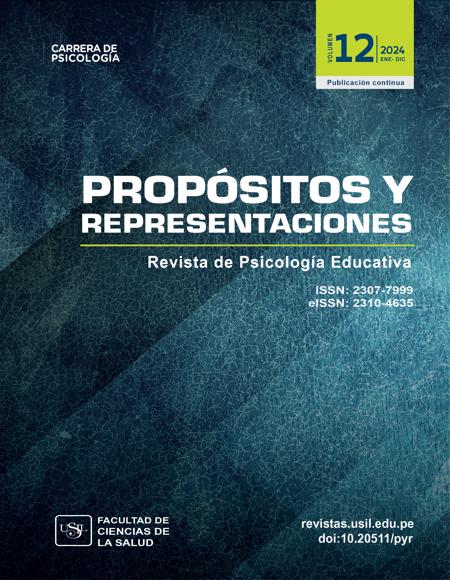Technological Infrastructure In Teaching-Learning Processes In Educational Institutions: A Systematic Review
Infraestructura tecnológica en los procesos de enseñanza-aprendizaje en instituciones educativas: una revisión sistemática
##plugins.themes.bootstrap3.article.main##
The COVID-19 pandemic accelerated the adoption of virtual and hybrid teaching methods, leading to substantial changes in educational approaches. This study focused on evaluating the effect of mediating technologies on post-pandemic educational processes, emphasizing their essential role in enhancing interaction and cooperation between teachers and students. Although their relevance is evident, challenges persist in terms of access, quality, and evaluation of technological educational initiatives. To address these challenges, a comprehensive literature review was conducted, examining 26 international academic studies published in the last five years. The findings indicate that mediating technologies positively influence motivation, student retention, and self-directed learning, especially in higher education and language teaching. However, the effects vary depending on the context. It is recommended to implement a technological strategy in the classroom that enhances learning and supports holistic education, highlighting the importance of developing comprehensive programs for planning, execution, and evaluation of educational technologies before applying these findings in specific contexts like Colombia.
##plugins.themes.bootstrap3.article.details##
Abuhassna, H., Al-Rahmi, W. M., Yahya, N., Zakaria, M. A. Z. M., Kosnin, A. B. M., & Darwish, M. (2020). Development of a new model on utilizing online learning platforms to improve students’ academic achievements and satisfaction. International Journal of Educational Technology in Higher Education, 17(1). https://doi.org/10.1186/s41239-020-00216-z
Acar, A., & Kayaoglu, M. N. (2020). Moodle as a potential tool for language education under the shadow of covid-19. Eurasian Journal of Educational Research, 2020(90), 67–82. https://doi.org/10.14689/ejer.2020.90.4
Adzovie, D., & Jibril, A. B. (2022). Assessment of the effects of Covid-19 pandemic on the prospects of e-learning in higher learning institutions: The mediating role of academic innovativeness and technological growth. Cogent Education, 9(1). https://doi.org/10.1080/2331186X.2022.2041222
Afonso, J. S., Martins, P. S., Barbosa, G. F., Ferreira, L., & Girao, M. J. B. C. (2018). Pedagogical mediation using the virtual learning environment and the new generation: A search for improved performance in medical education. Journal of Advances in Medical Education & Professionalism, 6(3), 115–122.
Aldahdouh, T. Z., Nokelainen, P., & Korhonen, V. (2020). Technology and Social Media Usage in Higher Education: The Influence of Individual Innovativeness. SAGE Open, 10(1). https://doi.org/10.1177/2158244019899441
Al-Daihani, S. M., Al-Qallaf, J. S., & AlSaheeb, S. A. (2018). Use of social media by social science academics for scholarly communication. Global Knowledge, Memory and Communication, 67(6–7), 412–424. https://doi.org/10.1108/GKMC-11-2017-0091
Australian Government Department of Education. (2023, February 9). Completion rates of higher education students - Cohort analysis, 2005-2021. Australian Government Department of Education. https://www.education.gov.au/higher-education-statistics/resources/completion-rates-higher-education-students-cohort-analysis-20052021
Baber, H. (2021). Modelling the acceptance of e-learning during the pandemic of COVID-19-A study of South Korea. International Journal of Management Education, 19(2). https://doi.org/10.1016/j.ijme.2021.100503
Baldwin, S. J., & Ching, Y. H. (2020). Guidelines for Designing Online Courses for Mobile Devices. TechTrends, 64(3), 413–422. https://doi.org/10.1007/s11528-019-00463-6
Balladares-Burgos, J., & Valverde-Berrocoso, J. (2022). El modelo tecnopedagógico TPACK y su incidencia en la formación docente: una revisión de la literatura. RECIE. Revista Caribeña de Investigación Educativa, 6(1), 63–72. https://doi.org/10.32541/recie.2022.v6i1.pp63-72
Banco Mundial. (2023). Personas que usan Internet (% de la población). Banco Mundial. https://datos.bancomundial.org/indicador/IT.NET.USER.ZS?end=2022&name_desc=false&start=1960&view=chart
Barfi, K. A., Arkorful, V., Appiah, F., Agyapong, E. M., & Acheampong, E. (2023). The impact of blended learning on students using the IBOX platform: Initial perspectives of teachers. Heliyon, 9(3). https://doi.org/10.1016/j.heliyon.2023.e14297
Barnes, S. J. (2020). Information management research and practice in the post-COVID-19 world. International Journal of Information Management, 55. https://doi.org/10.1016/j.ijinfomgt.2020.102175
Bizami, N. A., Tasir, Z., & Kew, S. N. (2023). Innovative pedagogical principles and technological tools capabilities for immersive blended learning: a systematic literature review. Education and Information Technologies, 28(2), 1373–1425. https://doi.org/10.1007/s10639-022-11243-w
Bond, M., Marín, V. I., Dolch, C., Bedenlier, S., & Zawacki-Richter, O. (2018). Digital transformation in German higher education: student and teacher perceptions and usage of digital media. International Journal of Educational Technology in Higher Education, 15(1). https://doi.org/10.1186/s41239-018-0130-1
Chaiyo, Y., & Nokham, R. (2017). The Effect of Kahoot, Quizizz and Google forms on the Student’s Perception in the Classrooms Response System. 2017 International Conference on Digital Arts, Media and Technology (ICDAMT), 178–182. https://doi.org/10.1109/ICDAMT.2017.7904957
Crisol-Moya, E., Herrera-Nieves, L., & Montes-Soldado, R. (2020). Virtual education for all: Systematic review. Education in the Knowledge Society, 21. https://doi.org/10.14201/eks.20327
Darvishi, A., Khosravi, H., Sadiq, S., & Gašević, D. (2022). Incorporating AI and learning analytics to build trustworthy peer assessment systems. British Journal of Educational Technology, 53(4), 844–875. https://doi.org/10.1111/bjet.13233
Davis, F. D. (1993). User acceptance on information technology- System characteristics, user perceptions and behavioral impacts. International Journal of Man-Machine Studies, 38(3), 475–487. https://doi.org/10.1006/imms.1993.1022
Departamento Administrativo de la Función Pública. (2020). Decreto 1419 de 2020: Por el cual se subroga la sección 1 del capítulo 2 del título 6 de la parte 2 del libro 2 del Decreto 1078 de 2015, Decreto Único Reglamentario del Sector de Tecnologías de la Información y las Comunicaciones. Diario Oficial de Colombia. https://www.funcionpublica.gov.co/eva/gestornormativo/norma_pdf.php?i=144825
Dianati, S., Nguyen, M., Dao, P., Iwashita, N., & Vasquez, C. (2020). Student perceptions of technological tools for flipped instruction: The case of Padlet, ¡Kahoot!, and Cirrus. Journal of University Teaching & Learning Practice, 17(5). https://ro.uow.edu.au/jutlp/vol17/iss5/4
Eichen, L., Hackl-Wimmer, S., Eglmaier, M. T. W., Lackner, H. K., Paechter, M., Rettenbacher, K., Rominger, C., & Walter-Laager, C. (2021). Families’ digital media use: Intentions, rules and activities. British Journal of Educational Technology, 52(6), 2162–2177. https://doi.org/10.1111/BJET.13161
Ergüzen, A., Erdal, E., Ünver, M., & Özcan, A. (2021). Improving technological infrastructure of distance education through trustworthy platform‐independent virtual software application pools. Applied Sciences, 11(3), 1–17. https://doi.org/10.3390/app11031214
España-Delgado, J. A. (2023). Kahoot, Quizizz, and Quizalize in the English Class and their Impact on Motivation. HOW, 30(1), 65–84. https://doi.org/10.19183/how.30.1.641
Fansury, A. H., Januarty, R., Rahman, A. W., & Syawal, S. (2020). Digital Content for Millennial Generations: Teaching the English Foreign Language Learner on COVID-19 Pandemic. Journal of Southwest Jiaotong University, 55(3). https://doi.org/10.35741/issn.0258-2724.55.3.40
Frango, I., Casali, A., Morales, A. V., Silva, A., Collazos, C. A., Cechinel, C., Muñoz-Arteaga, J., Maldonado-Mahauad, J., Chacón Rivas, M., Motz, R., Rodés, V., & Ochoa, X. (2021). Iguales en las diferencias: iniciativas de investigación transnacionales sobre Informática Educativa en Latinoamérica en el periodo 2010-2020. Revista Brasileira de Informática Na Educação, 29, 1060–1090.
Gough, D., Thomas, J., & Oliver, S. (2019). Clarifying differences between reviews within evidence ecosystems. Systematic Reviews, 8(1). https://doi.org/10.1186/s13643-019-1089-2
Habib, M. (2023). Digital transformation strategy for developing higher education in conflict-affected societies. Social Sciences and Humanities Open, 8(1). https://doi.org/10.1016/j.ssaho.2023.100627
Haleem, A., Javaid, M., Qadri, M. A., & Suman, R. (2022). Understanding the role of digital technologies in education: A review. Sustainable Operations and Computers, 3, 275–285. https://doi.org/10.1016/j.susoc.2022.05.004
Hidayat-ur-Rehman, I., Akram, M. S., Malik, A., Mokhtar, S. A., Bhatti, Z. A., & Khan, M. A. (2020). Exploring the determinants of digital content adoption by academics: the moderating role of environmental concerns and price value. SAGE Open, 10(2). https://doi.org/10.1177/2158244020931856
Horst, S. O., & Hitters, E. (2020). Digital media entrepreneurship: implications for strategic identity work and knowledge sharing of beginning entrepreneurs. Nordic Journal of Media Management Issue, 1(1), 23–44. https://doi.org/10.5278/njmm.2597-0445.3612
Hussaeni, S., Pratama, H., Arifin, R. A., Winda, A., & Widianingsih, S. (2020). The Use of YouTube as a Learning Tool in Teaching Listening Skill. International Journal of Global Operations Research, 1(3), 123–129. http://www.iorajournal.org/index.php/ijgor/article/view/50/57
Jara, I. (2015). Infraestructura digital para educación: avances y desafíos para Latinoamérica. UNESCO. https://unesdoc.unesco.org/ark:/48223/pf0000371044
Jie, Z., & Sunze, Y. (2022). A mobile pedagogical framework for enhancing online teaching and learning in higher education. Interactive Learning Environments. https://doi.org/10.1080/10494820.2022.2039945
Kamali, A., Yavuz, T., & Tabak, H. (2022). Learning mediation via Web 2.0 tools in the context of school health and safety. Research in Pedagogy, 12(1), 127–146. https://doi.org/10.5937/istrped2201127k
Khalid, M., Hossain, M. S., & Gregory, S. (2023). Contextual variation on teachers’ conceptions of ICT-enhanced teaching in engineering education. Heliyon, 9(3). https://doi.org/10.1016/j.heliyon.2023.e14531
Kouser, S., & Majid, I. (2021). Technological tools for enhancing teaching and learning process. Towards Excellence: An Indexed, Refereed & Peer Reviewed. Journal of Higher Education, 13(1), 366–373. https://doi.org/10.37867/te130133
Lenkaitis, C. A. (2020). Technology as a mediating tool: videoconferencing, L2 learning, and learner autonomy. Computer Assisted Language Learning, 33(5–6), 483–509. https://doi.org/10.1080/09588221.2019.1572018
Liu, Z. Y., Lomovtseva, N., & Korobeynikova, E. (2020). Online learning platforms: Reconstructing modern higher education. International Journal of Emerging Technologies in Learning, 15(13), 4–21. https://doi.org/10.3991/ijet.v15i13.14645
López-Tocón, I. (2021). Moodle quizzes as a continuous assessment in higher education: An exploratory approach in physical chemistry. Education Sciences, 11(9). https://doi.org/10.3390/educsci11090500
Makruf, I., Rifa’i, A. A., & Triana, Y. (2022). Moodle-based online learning management in higher education. International Journal of Instruction, 15(1), 135–152. https://doi.org/10.29333/iji.2022.1518a
Marcelo, C., & Yot-Domínguez, C. (2019). From chalk to keyboard in higher education classrooms: changes and coherence when integrating technological knowledge into pedagogical content knowledge. Journal of Further and Higher Education, 43(7), 975–988. https://doi.org/10.1080/0309877X.2018.1429584
Marks, B., & Thomas, J. (2022). Adoption of virtual reality technology in higher education: An evaluation of five teaching semesters in a purpose-designed laboratory. Education and Information Technologies, 27(1), 1287–1305. https://doi.org/10.1007/s10639-021-10653-6
Martin, F., & Bolliger, D. U. (2023). Designing Online Learning in Higher Education. In O. Zawacki-Richter & I. Jung (Eds.), Handbook of Open, Distance and Digital Education (pp. 1217–1236). Springer. https://doi.org/10.1007/978-981-19-2080-6
Maziriri, E. T., Gapa, P., & Chuchu, T. (2020). Student perceptions towards the use of youtube as an educational tool for learning and tutorials. International Journal of Instruction, 13(2), 119–138. https://doi.org/10.29333/iji.2020.1329a
Meier, E. B. (2021). Designing and using digital platforms for 21st century learning. Educational Technology Research and Development, 69(1), 217–220. https://doi.org/10.1007/s11423-020-09880-4
Ministerio de Educación Nacional de Colombia & Centro Regional para el Fomento del Libro en América Latina y el Caribe. (2022). Más y mejores aprendizajes: Política pública de recursos educativos. MEN-CERLALC.
Muñoz, H. A. (2016). Mediaciones tecnológicas: Nuevos escenarios de la práctica pedagógica. Praxis & Saber, 7(13), 199–221. http://www.scielo.org.co/pdf/prasa/v7n13/v7n13a10.pdf
Organización de las Naciones Unidas para la Educación, la Ciencia y la Cultura. (2015). Declaración de Incheon y marco de acción para la realización del objetivo de desarrollo sostenible 4. UNESCO. https://unesdoc.unesco.org/ark:/48223/pf0000245656_spa
Organización de las Naciones Unidas para la Educación, la Ciencia y la Cultura. (2021). Estrategia de la UNESCO sobre la innovación tecnológica en la educación (2022-2025). UNESCO. https://unesdoc.unesco.org/ark:/48223/pf0000378847_spa
Paetsch, J., Franz, S., & Wolter, I. (2023). Changes in early career teachers’ technology use for teaching: The roles of teacher self-efficacy, ICT literacy, and experience during COVID-19 school closure. Teaching and Teacher Education, 135. https://doi.org/10.1016/j.tate.2023.104318
Page, M. J., McKenzie, J. E., Bossuyt, P. M., Boutron, I., Hoffmann, T. C., Mulrow, C. D., Shamseer, L., Tetzlaff, J. M., Akl, E. A., Brennan, S. E., Chou, R., Glanville, J., Grimshaw, J. M., Hróbjartsson, A., Lalu, M. M., Li, T., Loder, E. W., Mayo-Wilson, E., McDonald, S., … Moher, D. (2021). Declaración PRISMA 2020: una guía actualizada para la publicación de revisiones sistemáticas. Revista Española de Cardiología, 74(9), 790–799. https://doi.org/10.1136/bmj.n71
Pardamean, B., Suparyanto, T., Cenggoro, T. W., Sudigyo, D., & Anugrahana, A. (2022). AI-Based Learning Style Prediction in Online Learning for Primary Education. IEEE Access, 10, 35725–35735. https://doi.org/10.1109/ACCESS.2022.3160177
Pirela, J., Pérez, L. E., & Pardo, L. E. (2022). Tendencias y retos de la formación docente en Iberoamérica. Revista de Ciencias Sociales, 28(4), 315–334. https://dialnet.unirioja.es/servlet/articulo?codigo=8703847
Pozo, J. I., Pérez, M. P., Casas-Mas, A., López-Íñiguez, G., Cabellos, B., Méndez, E., Torrado, J. A., & Baño, L. (2022). Teaching and learning musical instruments through ICT: the impact of the COVID-19 pandemic lockdown. Heliyon, 8(1). https://doi.org/10.1016/j.heliyon.2022.e08761
Quispe, A. M., Hinojosa-Ticona, Y., Miranda, H. A., & Sedano, C. A. (2021). Serie de redacción científica: Revisiones sistemáticas. Revista del Cuerpo Médico Hospital Nacional Almanzor Aguinaga Asenjo, 14(1), 94–99. https://doi.org/10.35434/rcmhnaaa.2021.141.906
Ramírez, M., Cortés, E., & Díaz, A. (2020). Technopedagogical mediation strategies in virtual learning environments. Apertura, 12(2), 132–149. https://doi.org/10.32870/Ap.v12n2.1875
Samoylenko, N., Zharko, L., & Glotova, A. (2022). Designing online learning environment: Ict tools and teaching strategies. Athens Journal of Education, 9(1), 49–62. https://doi.org/10.30958/AJE.9-1-4
Shurygin, V., Berestova, A., Litvinova, T., Kolpak, E., & Nureyeva, A. (2021). Universal models and platforms in E-Learning. International Journal of Emerging Technologies in Learning, 16(9), 63–75. https://doi.org/10.3991/ijet.v16i09.19697
Stevens, G. J., Bienz, T., Wali, N., Condie, J., & Schismenos, S. (2021). Online university education is the new normal: ¿but is face-to-face better? Interactive Technology and Smart Education, 18(3), 278–297. https://doi.org/10.1108/ITSE-08-2020-0181/FULL/PDF
Troussas, C., Krouska, A., & Sgouropoulou, C. (2020). Collaboration and fuzzy-modeled personalization for mobile game-based learning in higher education. Computers and Education, 144. https://doi.org/10.1016/j.compedu.2019.103698
Tseng, H., Yi, X., & Cunningham, B. J. (2022). Learning technology acceptance and continuance intention among business students: The mediating effects of confirmation, flow, and engagement. Australasian Journal of Educational Technology, 38(3), 70–86.
Turgut, Y. E., & Aslan, A. (2021). Factors affecting ICT integration in TURKISH education: a systematic review. Education and Information Technologies, 26(4), 4069–4092. https://doi.org/10.1007/s10639-021-10441-2
Uman, L. S. (2011). Systematic reviews and Meta-Analyses. J Can Acad Child Adolesc Psychiatry, 20(1), 57–59. https://www.ncbi.nlm.nih.gov/pmc/articles/PMC3024725/
Vandeyar, T. (2020). The academic turn: Social media in higher education. Education and Information Technologies, 25(6), 5617–5635. https://doi.org/10.1007/s10639-020-10240-1
Vieira, C. R., & Pedro, N. (2023). Weaknesses of ICT integration in the initial teacher education curriculum. Computers and Education Open, 5, 100150. https://doi.org/10.1016/j.caeo.2023.100150
Wagiran, W., Suharjana, S., Nurtanto, M., & Mutohhari, F. (2022). Determining the e-learning readiness of higher education students: A study during the COVID-19 pandemic. Heliyon, 8(10). https://doi.org/10.1016/j.heliyon.2022.e11160
West, R. E. (2023). Introduction to Design, Delivery, and Assessment in ODDE. In Handbook of Open, Distance and Digital Education (pp. 1149–1158). Springer.
Whitworth, K., Donnellan-Fernandez, R., & Fleet, J. A. (2023). Digital transformation of antenatal education: A descriptive exploratory study of women’s experiences of online antenatal education. Women and Birth. https://doi.org/10.1016/j.wombi.2023.08.008















